
The 5th position on the violin explained in the form of questions and answers.
If you’re reading this article because you’ve already mastered the first four positions on the violin, or even just the first and third positions, congratulations! You have made much progress and have obviously dedicated a lot of hours to practice.
The 5th position on the violin is not for beginners and opens the door for advanced repertoire. There are several violinists who have never learned how to play in it, especially folk musicians, so give yourself a pat on the back. Your previous experience and practice will come in handy for mastering it, even though it is a bit tricky.
This Q&A article will help you understand the position as well as give you some tips for mastering it. As one of the higher positions, it can give you access to higher notes and even more smart fingering.
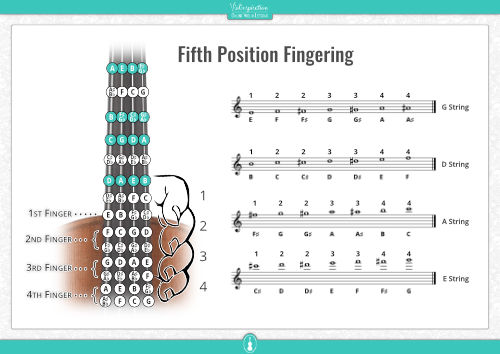
Download Free Violin Fingering Cheat Sheet
for the Fifth Position
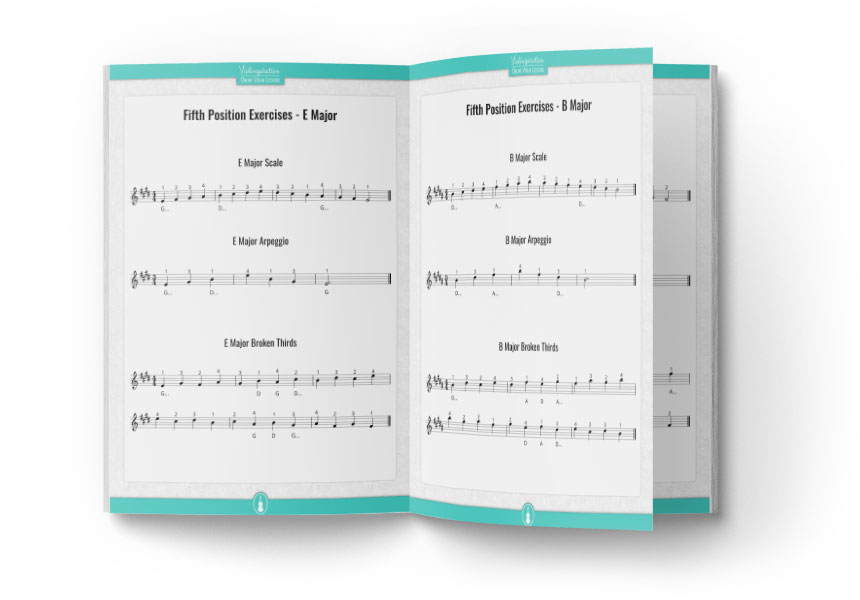
Free Booklet with Essential Exercises
in Fifth Position on a Violin
What Are the Benefits of Learning the Fifth Position?
The benefits of learning the fifth position are the following:
- You can play two more notes on the E string
- You can apply smart fingering
- A whole lot more repertoire is available to you, some of it considered a gateway to advanced music pieces and concertos
- After practicing the fifth position, you probably won’t need that much practice for the higher positions, as they are only used occasionally, and only in demanding repertoire.
While the third position gave you a new playground, the 5th violin position will give you a whole new perspective on how you can implement different positions in your playing.
You won’t get anything new, except for the two additional notes on the E string, but you’ll improve on what you already have. The fifth position is less commonly used than the first position or the third position; it’s not a position you will stay for an extended period of time – rather, you will usually pass by for a short time.
What Are the Pieces to Play up to the Fifth Position?
The pieces to play up to the fifth position on a violin include “Le Cygne” (the Swan) by C. Saint-Saëns, “Czardas” by V. Monti, “Adagio for Strings” by S. Barber, and Concerto no. 9 in A Minor by Ch. Beriot.
You should be aware that there are many music pieces you can play if you know first, third, and fifth positions and even more if you have gone through second and fourth.
Now, let’s listen to some of the most beautiful pieces to play on the violin up to the 5th position:
“Le Cygne” by Camille Saint-Saëns
Le Cygne, or The Swan, a part of Saint-Saëns’ famous The Carnival of the Animals is composed for a cello and two pianos. Here, you can hear it played by a violin and accompanied by a piano.
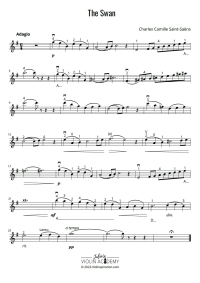
The Swan (Le Cygne)
by Charles-Camille Saint-Saëns
“Czardas” by Vittorio Monti
A very well-known piece of music is “Czardas” by Vittorio Monti. It is based on a traditional Hungarian dance and its original instrumentation is for violin, mandolin, and piano, but there are arrangements for virtually any combination or solo instrument with accompaniment. It is frequently used as an encore, so you might use this later in your violin career.
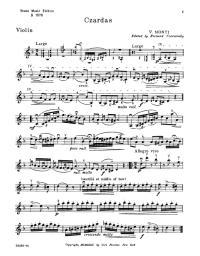
Czardas
by Vittorio Monti
“Adagio for Strings” by Samuel Barber
“Adagio for Strings” is Samuel Barber’s most famous work, originally appearing in his String Quartet Op 11. It is a very sad piece, one that many people recognize as it has appeared in several movies.
Concerto No. 9 in A Minor by Charles Auguste de Bériot
There are a few concertos that pave the way for the famous violin concertos. These help you understand how a concerto works but also help you open your mind to what the violin can do. After playing a couple of them, you will feel better prepared for any challenge.
Charles Auguste de Bériot’s Concerto No. 9 in A minor is one of his most famous works. Of course, you will need more than knowing the fifth position, as it makes use of double stops, octaves, and more advanced violin techniques. But if you’ve come this far, you are probably familiar with at least some of them.
How Do You Play the Fifth Position on a Violin?
You play the fifth position on a violin using the same fingering as in the first position. The difference is that it’s all on one string below and your left hand is higher on the fingerboard.
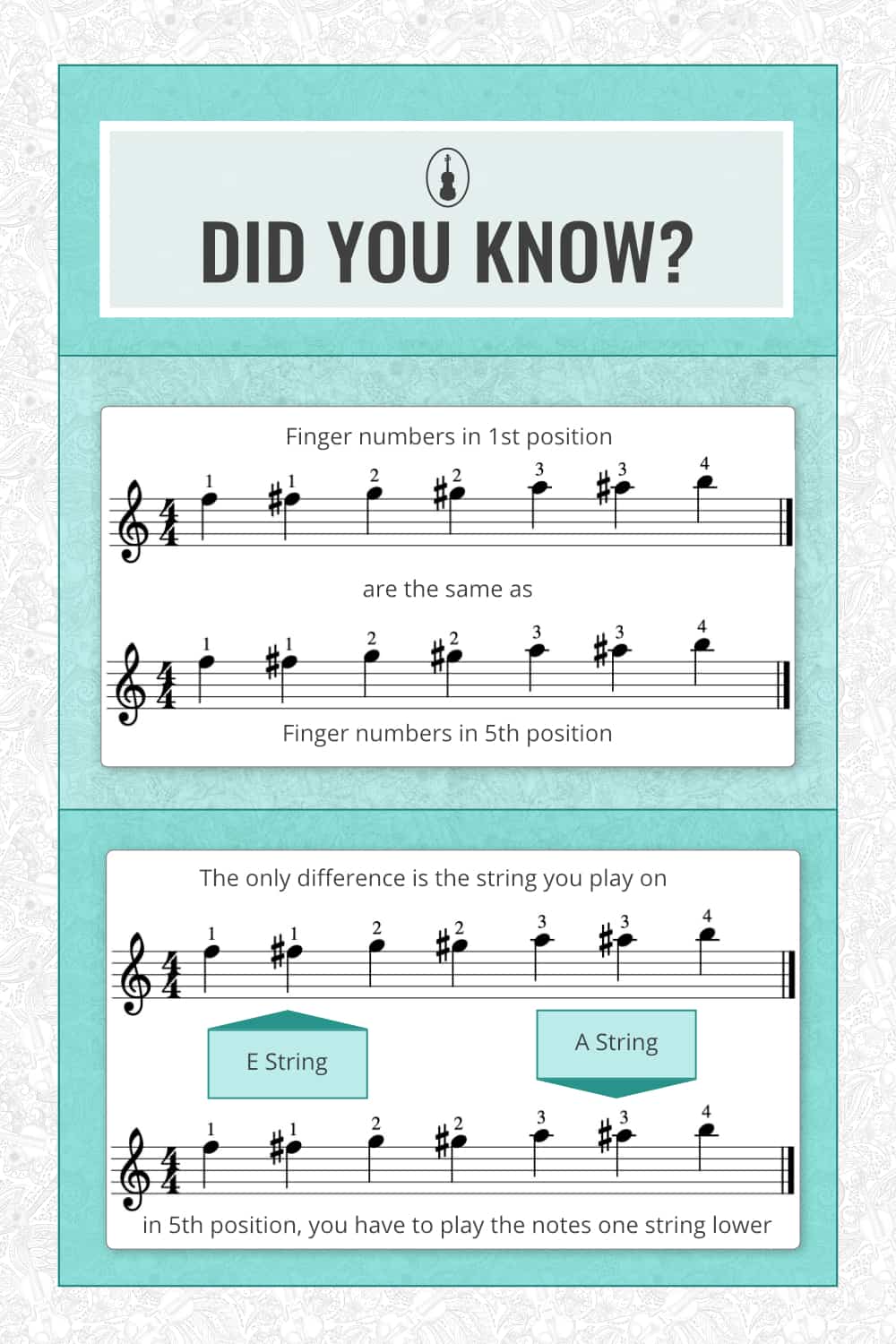
On the G string, for example, you can find the same notes you’re playing on the D string in the first position, except the open string of course.
However, you have to be careful! The intervals between fingers are getting smaller, so you have to be extremely precise. If your fingers are too big, you’ll probably have to move them slightly to fit the next position. Don’t do any abrupt moves, though: with each finger put in position, the previous one might have to slightly slide backward in order to get good intonation. This needs a lot of practice, in case you need to play in the fifth position fast, so that the sliding sound won’t be heard.
What Are the Notes in the Fifth Position?
The notes in the 5th violin position are the following:
- On the G string: E, F, F#/Gb, G, G#/Ab, and A. You can also easily play D#/Eb with your first finger.
- On the D string: B, C, C#/Db, D, D#/Eb, and E. Similarly, B can easily become A#/Bb.
- On the A string: F, F#/Gb, G, G#/Ab, A, and B.
- And finally on the E string: C, C#/Db, D, D#/Eb, E, and F.
The notes in the fifth position are the same as in first position, except it’s a string lower. Also, it’s similar to the half position, and since you are that high on the fingerboard, you will be able to play some of the notes nearby with ease.


Download Free Violin Fingering Cheat Sheet
for the Fifth Position
What Is the Best Time to Learn the Fifth Position?
The best time to learn the fifth position on a violin is after mastering the first and third positions. These are the three easiest positions, so you can use this order. Knowing them, you’ll be able to play more advanced repertoire and make the harder positions look easier.
Another method is after mastering the third position, go back to second and after that, start learning fourth and fifth. This way, you’ll know the two basic positions, then start filling the gap between them and go higher. Learning the second position first will be helpful for the fourth and make the fifth look even easier.
Whichever method you prefer, knowing the first and third positions as well as mastering shifting techniques is fundamental before ever trying to learn any other position.
What Is the Correct Posture in the Fifth Position?
The correct posture in the fifth position requires holding the violin with your chin. The left hand and elbow need to be moved more to the front, the thumb slides under the neck, and the hand touches the body of the violin.
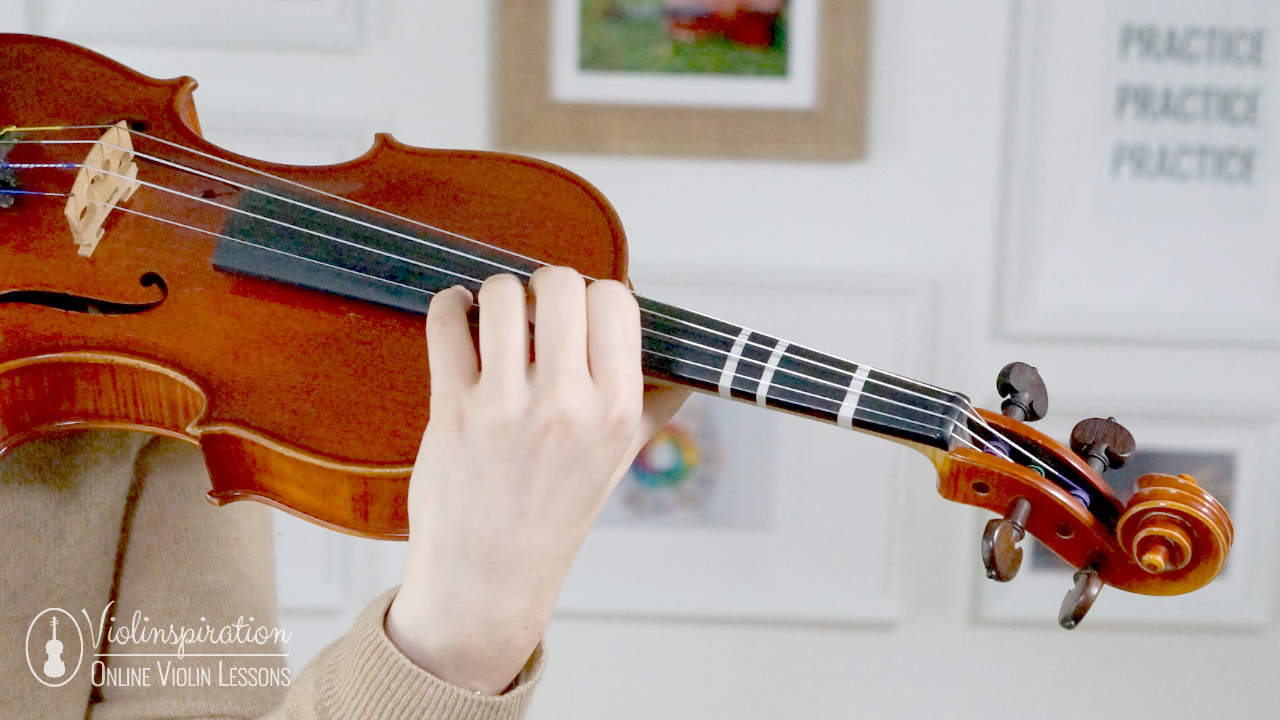
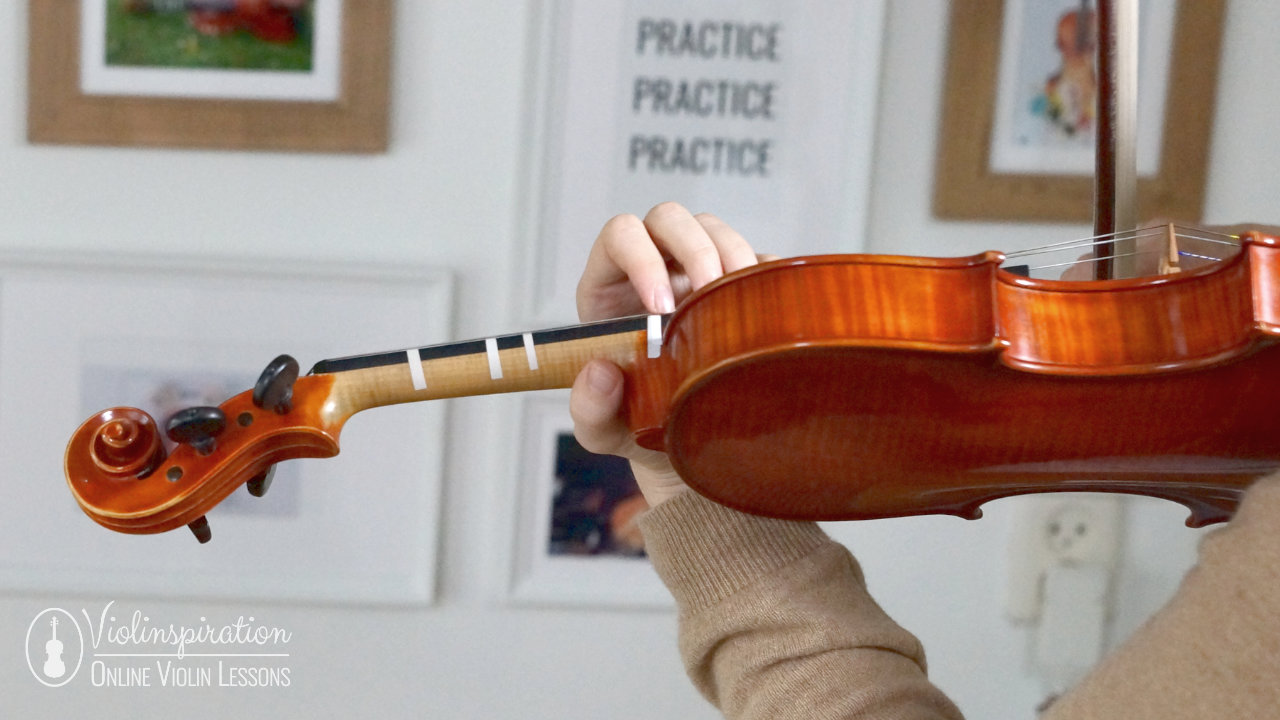
Your posture is of course very important, especially when you’re shifting. As is covered in my previous articles (Insight to Mastering the Violin: The Third Position and The Ultimate Guide to the Violin Positions), the move should be initiated with your elbow rather than wrist or forearm. It is important that your posture does not change when shifting, which can be achieved by holding the violin with your chin rather than your hand.
However, you do have to change your hand position a little. In the fifth or higher positions, your left hand is touching the body of the violin and your thumb must slide under the neck. The thumb position makes it easier for your fingers to reach the higher notes in the fifth or higher position.
This might make you apply pressure to your first finger and your thumb, which will then tighten up the rest of your fingers. Basic violin techniques apply here of course, so try to rest your hand in a relaxed position and always check if you’re holding the violin with your chin.
Finally, when you’re playing on the G string, remember to bring the left hand elbow under the instrument, or more to the front. Otherwise, your fingers won’t be able to play the notes, because you won’t be able to reach them.
For members of Julia’s Violin Academy: if you’re unsure whether your posture is correct or not, make sure to submit your feedback video here.
How to Find the 5th Position on a Violin
The fifth position on a violin can be found using one of the following three ways:
1. Find the fifth position by starting in the third position
The fifth position can be found by firstly placing the left hand in the third position, then placing your third finger in the appropriate position, and then changing it with the first finger.
For example, if you’re playing on the A string, find the correct fingering in the third position, starting from the first finger, and then ascend to the next, until you find F. Now shift your hand so the first finger is in the exact place where your third was and you’re done!
2. Find the fifth position by using natural harmonics
Another way to find the fifth position is to try and test with the natural harmonics. The third finger on any given string in fifth position plays the same note as the natural octave harmonic. For example, find the natural harmonic on the G string. Next, put your third finger in the exact spot so as to sound identical in intonation with the natural harmonic. Now you’re in the fifth position.
3. Find the fifth position using perfect fifths
A third and slightly more advanced way, and a good exercise to practice your relative hearing, is to play the first finger on any given string, for example the D, and then shift it right to the fifth position. So in this example, go from E to B. That’s a perfect fifth, so it’s not as difficult as it seems!
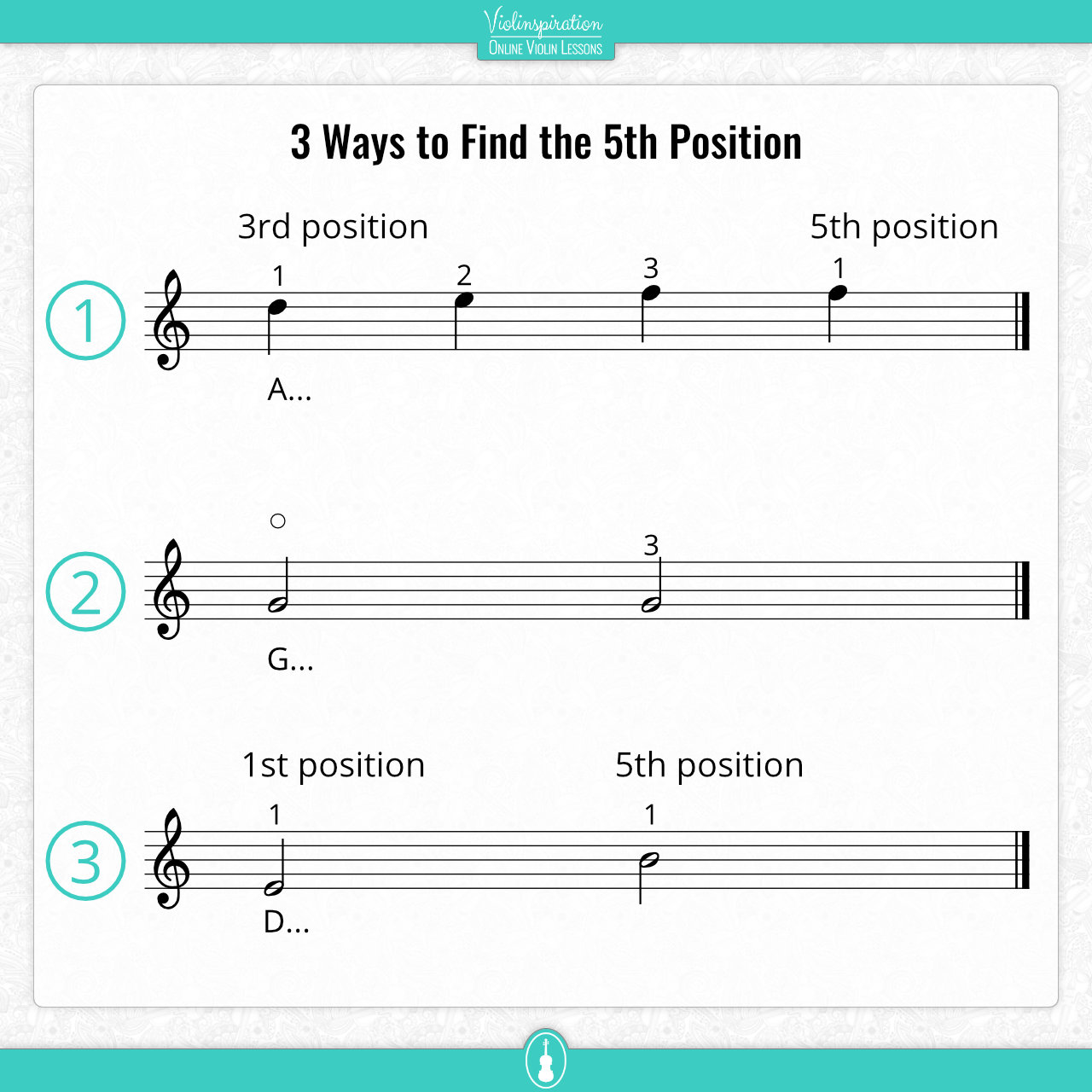
Does the Technique Change in the Fifth Position?
Yes, your playing technique changes in the fifth position. There are three key differences that you need to know and master. Otherwise, it will seem difficult to play in this position, and your tone will not be very good.
1. Intervals in the fifth position
The intervals are becoming smaller. You need to be very careful and precise on intonation with your left hand. The spot you press your finger on has to be very on point – half a centimeter away, it’s a different note.
2. String crossings
Another thing you have to be careful of is string crossing. At that height, the pressed string is lower than usual, so be careful when you move from one string to the other. Your fingers might catch upon the strings you’re not playing, and these are unnecessary noises you want to avoid. Be very delicate as you change your fingers, until you feel comfortable playing in the fifth position.
3. Bowing
Finally, you have to move the bow a bit closer to the bridge. This is needed for two reasons. Firstly, the pressed string is lower, so if you move the bow closer to the bridge, you’ll avoid playing a string you’re not meant to play. Secondly, because the notes in the higher positions sound lower in volume, playing closer to the bridge will help with increasing the volume.
How to Build a Strong Fifth Position Foundation
A strong foundation for the fifth position can be built by following these tips:
1. Be sure to master the first and third positions first!
These are essential positions and they will help you understand violin positions and shifting before moving to the higher positions.
2. Master all kinds of shifting with any finger
If you’re unsure when changing between first and third position, you will have a hard time with the fifth.
3. It needs repeating: keep your good posture and don’t apply too much pressure to your fingers
No movement should be initiated by your wrist or forearm, but with the elbow. You should always have your posture in mind, as it will allow you to play more easily and you can avoid feeling pain.
4. Master shifting between all three positions (or more, if you have studied them)
When you play intermediate and advanced pieces, you often have to quickly switch between positions. Practicing it in advance will allow you to learn a new piece quicker.
5. Learn the notes in the fifth position
You will be one step closer to fluent sight reading each time you learn the notes in the given position. You can find some tricks that will help you remember these notes (see next point).
6. Play all the notes in the fifth position and say their names
Do this before any exercises or scales. It will not only help you remember them, but you will start to learn the distance between each finger, as well as understand string crossing.
7. Always keep in mind the sound quality
Be careful with your bow; always have in mind that you have to produce quality sound. Keep it a bit closer to the bridge.
By following these steps, you will be prepared for any challenges in the fifth position. Of course, you need practice and patience, but if you know the previous positions, the fifth position won’t be difficult!
What Are the Essential Exercises in Fifth Position?
The essential exercises in fifth position include: scales, arpeggios, broken thirds, etudes, and exercises from books about shifting and violin techniques.
Remember when I said that you can find the fifth position by playing the first finger in the first position, then shift to the fifth? That’s a very good exercise in itself! As covered, it helps your relative hearing and it gives you a better understanding of the distance between those two positions on the violin.
Scales are always good to practice. You can start by playing one octave E, B, and F Major (and maybe Eb, Bb, and F# Minor too) on the G, D, and A strings respectively. If you’re feeling comfortable with that, try two octaves in E Major, starting from the G string and ending on the E string, which covers the entirety of the position. Some arpeggios in various scales always help, and you should also try broken thirds.

Free Booklet with Essential Exercises
in Fifth Position on a Violin
Which Books Can Help You Practice to Master the Fifth Position?
Most of the books you might already be aware of can be very useful. Some of them I have covered in my previous post about books helpful for learning the violin. However, if you’re studying the fifth position, that means you can expand on your repertoire and try harder exercises. These are some of the books I use most of the time:
“Introducing the Positions – Volume 1” by Harvey S. Whistler
Volume 1 covers the third and fifth positions. It has several shifting exercises, small etudes, and easy scales, as well as some easy music pieces you can try. One of the best books for any violin student who is learning the positions – or even return to it occasionally and use it as a warm-up.
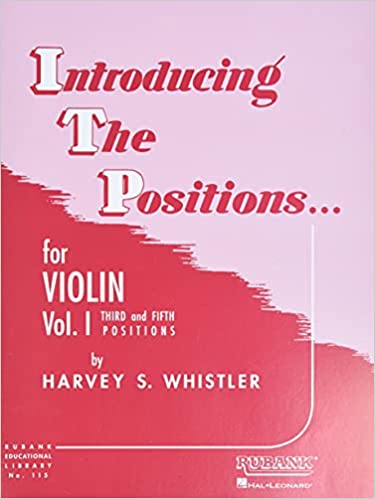
Introducing the Positions – Volume 1
by Harvey S. Whistler
Support us for more FREE content No extra costs for you Recommended by Violinists
“School of Violin Technique” by Otakar Ševčík
Ševčík wrote many books that can help any violinist at any level. Since you’re studying the fifth position, that means you’re intermediate going to advanced, so you can try a lot of them, even if it’s not a dedicated fifth position book. Opus 7 “Preparatory Studies to the Shake” has some fifth position exercises, and Opus 8 “Changes of Position and Preparatory Scale Studies” has many of them! However, you do need to know the rest of the positions (second and fourth), so proceed only if you have studied them.
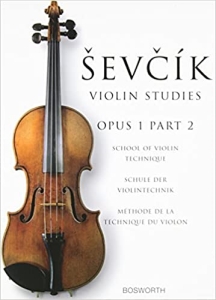
School of Violin Technique
Op. 1, part 2 by Otakar Ševčík
“School of Violin Techniques” by Henry Schradieck
This book has exercises in all positions in order. After the fifth position, it also has some passing through all five of them. It is a good supplementary book if you’re trying to play more exercises or want to see something different.
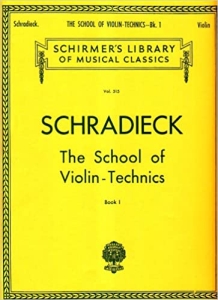
School of Violin Techniques
by Henry Schradieck
“Scale-Studies for Violin” by Jan Hřímalý
This is a very good scale system that is worth coming back to. It has scales in all positions, as well as arpeggios, broken thirds, double stops, etc. A great tool not only for mastering scales but mastering the positions too!
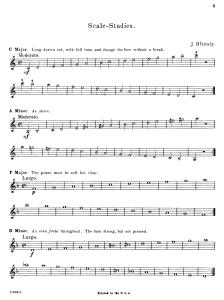
Scale-Studies for Violin
by Jan Hřímalý
“Etudes, Op. 36” by Jacques Féréol Mazas
If you have already started studying this book, you should continue! A great tool to make the way to more advanced studies and capriccios easier. You won’t find dedicated fifth position studies here, but melodies that make use of shifting and different positions as well as other violin techniques.

Etudes, Op. 36 (book 1 & 2)
by Jacques Féréol Mazas
“42 Études or Capriccios” by Rodolphe Kreutzer
Kreutzer was a violinist, composer, and pedagogue, maybe best known as the dedicatee of Beethoven’s Violin Sonata No. 9. His 42 studies have remained a staple of the violin teaching repertoire since their publication and for good reason. A teacher of mine once called it “the Bible.” Some studies go beyond the fifth position, but if you have practiced Kayser and Mazas etudes, this is the next logical step.

Kreutzer 42 Studies or Caprices
Support us for more FREE content No extra costs for you Recommended by Violinists
“Scale System” by Carl Flesch
Flesch’s Scale System is hands down the best scale system for the violin! It’s not easy, it’s very irritating, but the benefits are priceless. Try it only if you have studied the rest of the positions, and after you’ve mastered the fifth and you’re feeling adventurous. It includes scales across the whole range of the strings and in all positions, double stops, arpeggios, and everything else, in a very organized manner.
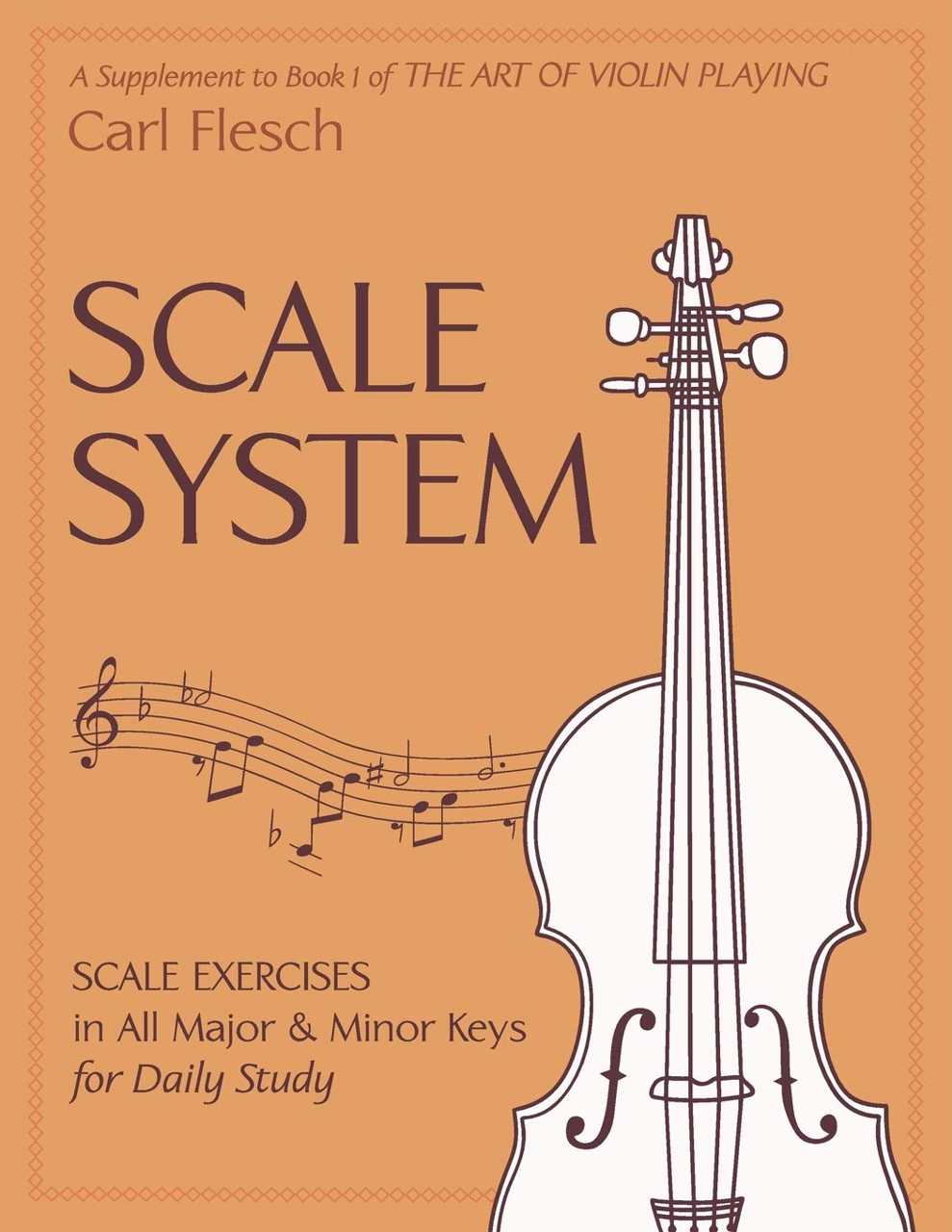
Scale System: Scale Exercises
in All Major and Minor Keys for Daily Study
Support us for more FREE content No extra costs for you Recommended by Violinists
What Are the Easy Songs for Shifting in the First Five Positions for Violin?
Easy songs that require shifting in the first five positions on the violin include:
- The old popular English song “Drink to Me Only with Thine Eyes,” which has been also covered by Johnny Cash, if you’re into that kind of music. This is the same song that I have also arranged for beginner violinists. You can challenge yourself and try to play it not in the first, but in the fifth position, replacing the open strings with the fourth finger on the proper string.
- “On Wings of Song” is a piece by Felix Mendelssohn and you can find a version here.
- There’s also a version of “Song to the Evening Star,” an aria from Richard Wagner’s opera “Tannhäuser.”
And there are some smaller pieces too, some chorales by Bach, etc. Also mentioned earlier, “Introducing the Positions” has some easy songs and solos that you can try.
These are versions of popular and well-known melodies that can help you get familiar with the fifth position through a tune you might recognize.
Charles Dancla was a French violinist and composer. His “Airs variés” is a compilation of variations on well-known classical themes by Donizetti, Rossini, Bellini, and others. These are not too demanding, while making great use of violin positions, and they are very melodic. Try these if you want to play something that sounds and feels closer to the violin repertoire.
Final Note
The fifth position is a great tool that will unlock many doors. While the third position makes you feel you’ve progressed one level, the fifth position will make you feel like you truly know your way around the violin fingerboard.
You need to be careful with some technique issues and intonation. Managing the position will show how determined you are to progress to the next level, but I hope you will have a great time playing more advanced pieces with the use of the 5th position. If you’d like my help in learning them, make sure to check out my Fifth Position Master Class.

Download Free Violin Fingering Cheat Sheet
for the Fifth Position

Free Booklet with Essential Exercises
in Fifth Position on a Violin























